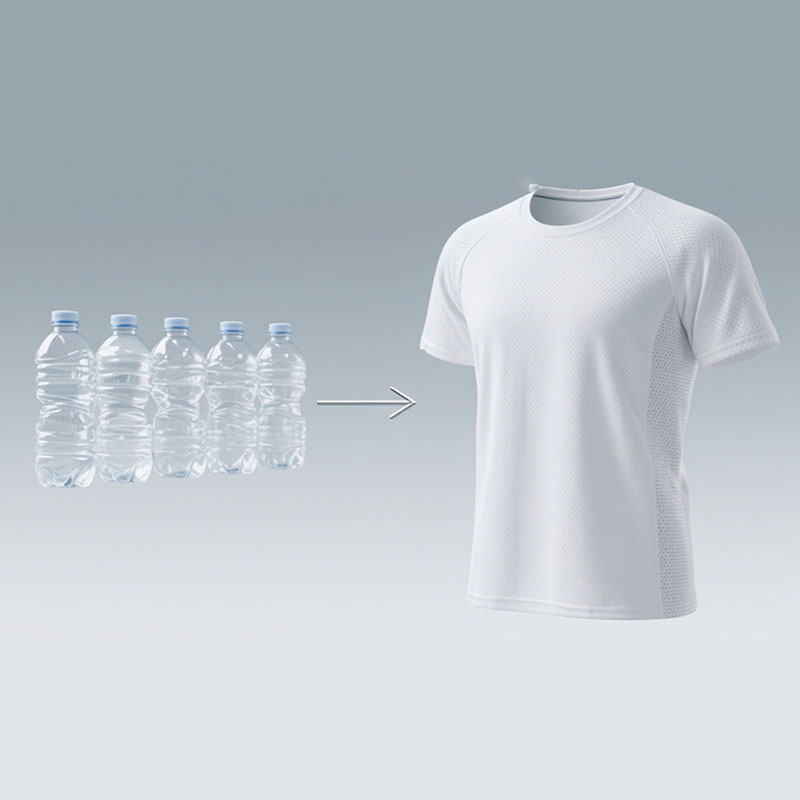When you spot runners in lightweight, breathable sportswear at the New York Marathon or catch a glimpse of yoga enthusiasts in quick-drying leggings at a Berlin gym, you might not realize—many of these high-frequency items on the shelves of European and American sportswear brands owe their existence to one “star fabric”: recycled polyester.
Why has this seemingly ordinary fabric stood out from countless textile materials in recent years, becoming a “must-have” for leading brands like Nike, Adidas, and Lululemon? Three core reasons lie behind its rise, each precisely aligning with the “urgent needs” of the European and American markets.
1. Eco-friendly Credentials: Hitting the “Survival Red Line” for Western Brands
In European and American markets, “sustainability” is no longer a marketing gimmick but a “hard requirement” for brands to stay relevant.
Recycled polyester represents an “environmental revolution” for the traditional textile industry: it uses waste plastic bottles and industrial scraps as raw materials, transformed into fibers through recycling, melting, and spinning processes. Statistics show that one recycled polyester sportswear item can reuse 6-8 plastic bottles on average, reducing carbon emissions by approximately 30% and water consumption by 50%.
This directly addresses two core demands in Western markets:
Policy Pressure: Regulations like the EU’s Carbon Border Adjustment Mechanism (CBAM) and the U.S. Textile Strategy explicitly require supply chains to reduce their carbon footprint. Using recycled materials has become a “shortcut” for brands to comply.
Consumer Demand: Among Western sports enthusiasts, 72% of respondents say they “are willing to pay a premium for eco-friendly fabrics” (2024 Sportswear Consumption Report). For brands, adopting recycled polyester wins recognition from environmental organizations and resonates with consumers.
Take Patagonia’s “Better Sweater” series, clearly labeled “100% recycled polyester.” Even with a 20% higher price tag than conventional styles, it remains a top seller—eco-labels have become a “traffic magnet” for Western sportswear brands.
2. Superior Performance: An “All-Rounder” for Athletic Scenes
Eco-friendliness alone isn’t enough; functionality—the “core job” of sportswear fabrics—is what keeps brands coming back. Recycled polyester holds its own against traditional polyester, and even outperforms it in key areas:
Moisture-Wicking & Quick-Drying: The fiber’s unique surface structure rapidly draws sweat away from the skin, keeping wearers dry during high-intensity activities like marathons or HIIT workouts.
Durable & Wrinkle-Resistant: Recycled polyester has a more stable molecular structure, retaining its shape even after repeated stretching and washing—solving the common issue of traditional sportswear “losing shape after a few washes.”
Lightweight & Elastic: 40% lighter than cotton, with a stretch recovery rate of over 95%, it minimizes movement restriction while adapting to large-range motions like yoga or dance.
What’s more, with technological advancements, recycled polyester can “stack functions”: adding antibacterial agents creates “odor-resistant fabrics,” while UV protection technology enables “outdoor sun-protective fabrics.” This “eco-friendly + versatile” combo makes it nearly “flawless” for athletic use.
3. Mature Supply Chain: A “Safety Net” for Brand Scalability
Western sportswear brands have strict supply chain demands: stable supply and cost control. Recycled polyester’s rapid popularity is backed by a well-established industrial chain.
Today, recycled polyester production—from material recycling and spinning to dyeing—follows standardized processes:
Reliable Capacity: China, the world’s largest producer of recycled polyester, boasts an annual output exceeding 5 million tons, meeting needs from small-batch custom orders for niche brands to million-unit orders for industry leaders.
Controllable Costs: Thanks to upgraded recycling technologies, recycled polyester now costs only 5%-10% more than traditional polyester—yet delivers significant “sustainability premiums” for brands.
Strong Compliance: Recycled polyester certified by the Global Recycled Standard (GRS) offers full raw material traceability, easily passing customs inspections and brand audits in Western markets.
This is why Puma announced in 2023 that “all products will use recycled polyester”—a mature supply chain has turned “sustainable transformation” from a slogan into a viable business strategy.
More Than a “Trend”—It’s the Future
Recycled polyester’s status as a favorite among Western sportswear brands stems from the perfect alignment of “environmental trends, functional needs, and supply chain support.” For brands, it’s not just a fabric choice but a “strategic tool” to compete in the market and achieve long-term sustainability.
As technology advances, recycled polyester will evolve to be “lighter, more breathable, and lower-carbon.” For textile foreign trade companies, seizing this fabric’s momentum means capturing the “entry point” to the European and American sportswear market—after all, in an era where eco-friendliness and performance go hand in hand, great fabrics speak for themselves.
Post time: Aug-11-2025

